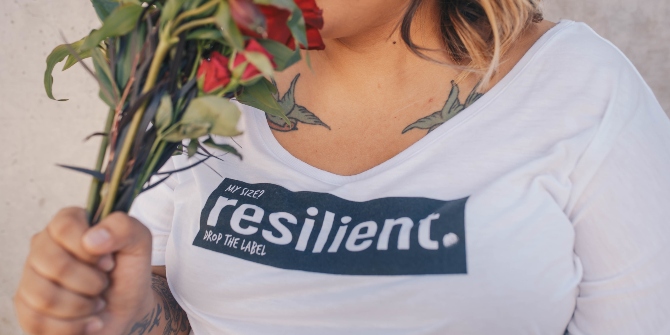 Emily Cousens, Visiting Lecturer at Oxford and Contributing Editor for the Media@LSE blog, looks at how and why the #MeToo movement has shifted away from being a mainstream news story in the UK but is still very much present as a protest movement elsewhere in the world.
Emily Cousens, Visiting Lecturer at Oxford and Contributing Editor for the Media@LSE blog, looks at how and why the #MeToo movement has shifted away from being a mainstream news story in the UK but is still very much present as a protest movement elsewhere in the world.
In October 2017, the actor Alyssa Milano tweeted ‘If you’ve been sexually harassed or assaulted write “me too” as a reply to this tweet’. The hashtag went viral. On Facebook it was shared in more than 12 million posts and reactions in the first 24 hours. Before long, the UK press were quick to declare ‘a #MeToo moment’, with months of media outrage following. The usual stories accompanying images of the women of Hollywood at the Oscars shifted their focus from what these women were wearing, to what had injustices hadbeen committed behind the scenes. Sex sells. Outrage sells. And Hollywood sells. And for a good six months in the UK, #MeToo sold too. So where is it now?
#MeToo as a popular feminist movement
When the #MeToo movement became a British media news story in 2017, it had three characteristics of what Sarah Banet-Weiser calls popular feminism:
Outrage economy
One characteristic of popular feminism is that it is part of the outrage economy which requires something to be newly discovered. The audience need to be shocked. As a result, long histories of organising against sexual violence were overlooked in media #MeToo reporting. Whilst most feminist organisers weren’t surprised to find that many women experience sexual harassment at work, for example, the news is. Sexual harassment was considered a newly discovered problem, yet newness has a shelf-line. And outrage tires. As a form of public outrage then, the anger against sexual harassment was inevitably short lived.
Individualising
A second characteristic of popular feminism is its focus on individuals, particularly celebrities. This was particularly the case for the #MeToo movement for a number of reasons. First, images of individuals are more compelling than images of groups and so stories that are accompanied by famous celebrities rather than, for example, images of collective protest tend to be favoured. Secondly, the media needs individual stories in order to ‘personify’ a problem, a key element of newsworthiness. Third, some individuals’ stories are of greater value and solicit public empathy more readily than others. And the mainstream reporting of the #MeToo movement in the UK, amplified the voices of white (also typically thin, privileged) victims over those of victims of colour.
Visibility over solutions
Popular feminism is characterised by visibility over solutions. Indeed, visibility and exposure will be taken as a solution to the problem. This means that while popular feminism ages quickly, and a movement can be built and forgotten in a very short space of time, grassroots feminism has a longer history and trajectory. The #MeToo movement was originally started by long-time organiser, Tarana Burke, in 2006 as a movement of survivors for women and girls of colour. Burke’s movement continues as a collective movement fighting for structural change.
Where is #MeToo now?
Whilst it’s no longer part of British popular feminism, having lost its capacity to generate outrage and lacking a new celebrity focus, neither the structural issues that the #MeToo movement highlighted, nor feminist organising to address these, have gone away. The popular feminist aspects of the #MeToo movement discussed above made it appealing to the UK press. However, these were also the aspects that favoured short-term visibility over long term change. By contrast, the aspects of the #MeToo movement which are not as media friendly: its global dimensions, its mobilisation of collectives and its goal of structural change have endured. Beyond the popular feminist frame, #MeToo movements across the world have continued to organise creatively against sexual violence.
A rapist in your path
Since 2019, a song titled A Rapist in your Path, written by Las Tesis, a Chilean feminist theatre group, has been taken up as a protest song and sung at marches and collective gatherings around the world, accompanied by music and dance steps. A Rapist in Your Path is based on the work of Argentinian theorist Rita Segato, who argues that sexual violence is a political problem, not a moral one. The lyrics centre on rape and address the structural nature of gender violence in society. The chorus line, “It wasn’t my fault; not where I was, not how I was dressed” challenges the way that women are blamed for experiences of sexual violence and the conclusion: “the rapist is you/It’s the cops/ The judges/ The state/ The president” describing how patriarchy is upheld by institutions. The song was first performed in November 2019 during Chile’s uprising against inequality and has since spread, first throughout Latin America and subsequently has been performed in Mexico, India, Kenya, France, Spain and the UK, by London Bridge.
#ProtestToo
Thousands of protesters wearing all-black poured into a park in Hong Kong’s business district, Central, in August 2019 under the slogan “stop Kong police’s use of sexual violence” and with #ProtestToo scrawled, often in lipstick, on their forearms. A key aspect of the anti-extradition movement in Hong Kong is a #MeToo movement.
#MeToo in Iran
In August 2020, a group of women journalists in Iran recorded a video in which they shared their experiences of newsroom harassment. This emerged as part of a ‘hashtag storm’ of thousands of women, and some men, speaking out, following an initial set of revelations, not involving powerful celebrities, but an ‘ordinary guy’ who would invite women over to eat and drink homemade wine, before drugging their drinks and assaulting them. This has spurred a government bill to outlaw sexual violence and harassment, which was approved in draft form in early January.
That #MeToo hasn’t gone away is no surprise. It was always here. But its quick rise and fall in the mainstream media is illustrative of the dynamics of popular feminism which sensationalises sexual violence to sell, not solve, the problem.
This article represents the views of the author and not the position of the Media@LSE blog, nor of the London School of Economics and Political Science. To learn more about the LSE Department of Media and Communication’s research, please sign up to our Media@LSE newsletter here.
Featured image: Photo by Mélodie Descoubes on Unsplash





